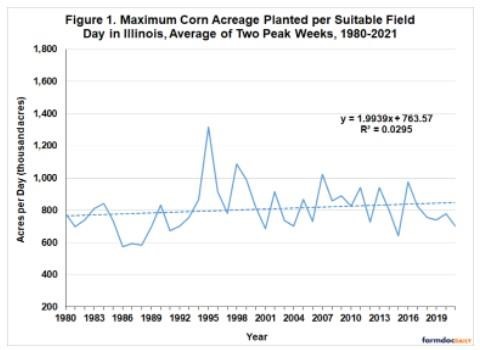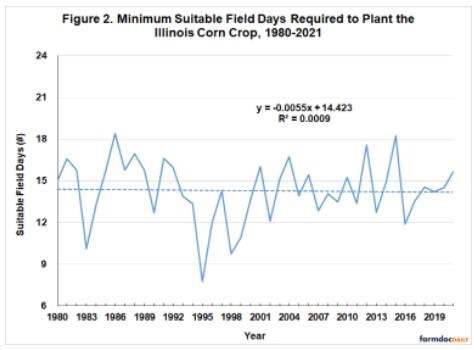Since we are interested in the minimum number of days that it is possible to plant the corn crop, we focus on weeks with the highest acreage planted per suitable field day. In other words, we want to know how fast the corn crop can be planted based on the highest rates of planting progress in the historical record. This should be kept in mind when considering the results of the analysis. Whether producers can actually maintain peak week progress for an extended period is uncertain. In addition, we average the progress per suitable field day for the two highest weeks each year to smooth out some outliers that appear in the single highest week each year.
Figure 1 presents the estimates of the maximum corn acreage planted per suitable field day in Illinois over 1980-2021. There is substantial variability from year-to-year, reflecting variation in spring weather conditions. However, there is no evidence of a pronounced upward trend in the maximums for Illinois, as they vary around a stable mean of about 800,000 acres per suitable field day. In other words, the estimates in Figure 1 show that maximum planting rates per suitable field day in the heart of the Corn Belt have, on average, changed little over time. This also indicates that investment in planting equipment during the last decade did not create extra capacity that could be called upon when conditions delayed planting substantially.

The next step of the analysis is to estimate the minimum number of days required to plant the corn crop in Illinois. We do this by dividing total planted acreage of corn in Illinois each year by the estimated maximum rate of corn planting progress per suitable field day shown in Figure 1. This provides an estimate of how fast the corn crop in Illinois can be planted assuming the rate of daily planting is at the maximum. The computation also takes into account the changing total planted acreage of corn in Illinois over time.
Figure 2 shows that estimated minimums for Illinois again vary depending on conditions in any particular year. But, once again, one is struck by the overall stability of the minimum number of days required to plant the Illinois corn crop. There is no trend over time around the long-term average of 14.3 suitable field days. It is important to emphasize that this is the estimated minimum number of suitable field days to plant the entire Illinois corn crop. Individual farm operations may need fewer days to complete planting.

Takeaways:
#1. There is considerable variability from year-to-year in peak rates of corn planting per suitable field day, reflecting variation in weather conditions during the spring planting period.
#2. There is no evidence of an upward trend in the peak rate of corn planting per suitable field day in Illinois.
#3. The expected peak rate of corn planting per suitable day in Illinois is about 800,000 acres, and this has not changed perceptibly over the last 40 years.
#4. On average, producers in Illinois need about 14 suitable field days, or two weeks, to plant the corn crop based on maximum daily rates of planting progress.
#5. Essentially, bigger but fewer corn planters today plant about the same acres per day in aggregate as more numerous but smaller planters did in the past.
Our earlier work shows that similar takeaways can be drawn from data for the other two “I-states” in the Corn Belt—Indiana and Iowa (farmdoc daily, April 19, 2018; April 17, 2019; April 16, 2020). These results have also been confirmed for Indiana recently by Nielsen (2022). Assuming these three I-states states are representative of the entire Corn Belt, then we can project that 14 days is the minimum number of suitable field days needed to plant the Corn Belt. We have also done similar computations for the larger number of states included in Crop Progress reports (farmdoc daily, April 3, 2020), but that data is only available starting in 1995. In recent years, the minimum number of suitable field days needed to plant the corn crop in the 17 major producing states was about 19 days, five days longer than in three I-states in the heart of the Corn Belt. It is not clear what explains the slower rate of maximum planting progress in states outside of Illinois, Indiana, and Iowa. Overall, this evidence suggests two to three weeks of suitable field days is the bare minimum needed to plant the entire U.S. corn crop.
The results have important implications for expectations about the timeliness of corn planting in 2022, which has obviously gotten off to a very slow start. Start with the conservative assumption that 14 suitable field days are needed at minimum to plant the Illinois corn crop. The next question is the probability of obtaining those 14 days over a given interval of time. Figure 3 provides the historical distribution of suitable field days per week during April-May in Illinois over 1980-2021. As expected, there is a wide range in the number of suitable days per week, reflecting extremes in weather during the spring planting window. For example, there is an 11.6 percent chance of one or seven suitable field days. The average number of suitable field days in Illinois during April and May is 3.6 days.

With this information we can assess the likelihood of the Illinois corn crop being planted in a timely fashion in 2022. In a farmdoc daily article last week (April 14, 2022), we presented agronomic field trial data showing that substantial yield penalties for late corn planting do not begin until after May 10th. There are 20 days to go until May 10th, or approximately three weeks. We also know that the latest planting progress report indicates zero planting progress in Illinois as of April 17th. If we assume that the average number of suitable field days per week (3.6) occur over each of the next three weeks, we would expect 3.6 x 3 = 10.8 suitable field days to occur. This is likely not a sufficient number of field days to plant the entire Illinois corn crop, but it would allow nearly 80 percent of the crop to be planted. In order to finish planting the entire crop in the next three weeks, 4.7 suitable field days would be needed in each of the next three weeks. Of course, these computations assume planting at near historical maximum rates per suitable field day, which is likely to be somewhat optimistic.
Implications
The speed at which corn planting can progress is of obvious importance in determining the likelihood of a substantial part of the crop being planted in a timely manner. Spurred on by the large size of modern planters that can plant many more acres than the smaller planters of the past, it is not uncommon to argue that fewer days are needed today to plant the entire U.S. corn crop now than in the past. We examine historical data on planting progress for Illinois to demonstrate what we know about aggregate corn planting speed. We show that maximum planting rates per suitable field day in the heart of the Corn Belt have increased very little over time and that it takes a minimum of about 14 days, or two weeks, to plant the corn crop. These findings imply that bigger but fewer planters today plant about the same acres per day in aggregate as more numerous but smaller planters did in the past. It is crucial to understand that these findings apply to an aggregate scale such as a state or the entire Corn Belt. There are undoubtedly some individual farm operations that can plant their total corn acreage faster than in the past. But when aggregating across all farm operations on a large scale the data indicate this is generally not the case.
We can combine this information with data on the distribution of suitable field days to assess the likelihood that the Illinois corn crop can still be planted in a timely fashion in 2022. Assuming the average historical number of field days occur each of the next three weeks, we estimate that nearly 80 percent of the Illinois corn crop can be planted by May 10th. However, the clock is ticking and further delays will almost certainly mean that a larger than normal number of corn acres will be planted late in the U.S. Corn Belt.
Source : illinois.edu